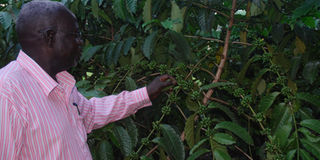Coffee roasts may earn you more

A farmer examines his coffee beans in a garden. photo by Fred Wambed
What you need to know:
The commonest way of describing coffee roast levels is by the colour of the roasted beans. It can range from light to dark or extra dark because their colour becomes darker as the beans absorb heat in the roasting process, writes Beatrice Nakibuuka
Coffee is one of the leading exports from Uganda and has the second quality and quantity at the world market, according to Edidah Kyoshabire, the quality assurance officer at Uganda Coffee Development Authority (UCDA).
Value addition
Every step taken in refining coffee is a step of value addition. It starts with garden preparation, the amount of fertilisers that you apply, mulching, and pruning until they are ready for harvest.
In the villages, farmers make the first step of value addition by harvesting the red beans and drying them. The drying can take about five to eight days.
The drying should, however, be on a clean surface and not on the bare ground. The farmers can use tarpaulins for drying and this should be thorough that no moisture is retained. Raised racks though expensive are also recommended.
Kyoshabire says, “Experienced coffee growers usually know when the beans are totally dry. Farmers in associations have collection centres where they use a moisture meter to ensure that the beans are totally dry.”
When middle men pick the dried coffee beans (black in colour) from the farmers, they take it for husk removal and sorting. Here the prices for these even go higher depending on the size and quality after grading them.
Process
There are people that choose to add value to coffee by roasting. They must have the machines first. A roaster can be about $28,000 (about Shs100m) but can change depending on the quality. The grinding can also take about $2,500 (about Shs9m) depending on the amount it can grind at a time.
Kyoshabire says, “The people who want to roast or even export coffee must first register with Uganda Coffee Development Authority (UCDA) at a fee of Shs1m to get their annual licence. UCDA then inspects the place to see if it is up to the standards, tastes the coffee for quality and then one is free to roast or export coffee.”
Roasting
According to Brian Masereka, the president of Kyambogo University Coffee Association, the degree to which coffee beans are roasted is very important because it is one of the factors that determine the taste of the coffee in the cup. Before roasting, green (Arabica) or greenish brown (Robusta) beans are soft, with a fresh smell and no taste. The roasting process transforms the raw beans into the distinctively aromatic, flavourful and crunchy beans.
He says, “The age of the coffee, the processing, grinding, and the brewing methods affect the taste. When coffee beans are harvested before ripening, they form dark marks, they are small, become chalky white and do not have the aroma.”
The roast level provides a baseline and gives a different taste. The commonest way of describing coffee roast levels is by the colour of the roasted beans. It can range from light to dark or extra dark because their colour becomes darker as the beans absorb heat in the roasting process.
Light roasts
These are usually light brown in colour, with no oil on the surface of the beans. It means that coffee beans have not been roasted beyond the first crack, says Magdalene Amulen, the business manager at La Marc Coffee.
She says, “The beans attain a roasted grain taste and distinct acidity. The original flavours of the bean are retained to a greater extent than
in darker roasted coffees. The light roasts also retain maximum amounts of the caffeine in the coffee bean.”
Medium roasts
Here the coffee beans become medium brown in colour with more body than light roasts but still have no oil on the bean surfaces. They at this time lack the grainy taste of the light roasts, exhibit more balanced flavour, aroma, and acidity. Caffeine is somehow decreased at this stage.
Medium-dark roasts
Medium-dark roasts have a darker colour with some oil beginning to show on the surface of the beans, says Amulen. A medium-dark roast has a heavy body in comparison with the lighter or medium roasts. The flavour and aroma of the roasting process become noticeable while losing the original flavour of the beans, and the taste of the coffee is spicy.
Dark roasts
She says, “Dark roasted coffees are dark brown or almost black in colour, like chocolate. They have a gloss of oil on the surface. The original flavours are manifested in this roasting process but the coffee will have a bitter and smoky or even burnt taste. The amount of caffeine is substantially decreased.”
It is important to note according to Amulen, that lighter roasts have more acidity than darker roasts and the caffeine level decreases as the roast gets darker.
Prices
The bigger beans of Robusta coffee for example are sold at Shs4,000 per kilogramme while that of Arabica can go up to Shs7,000.
These beans at this point can be exported the way they are or roasted to form a powder which can also be exported or sold locally in the supermarkets.
On average 250 grammes of medium roasted coffee powder costs Shs15,000 while 500 grammes of roasted beans in a sachet goes for Shs25,000.




